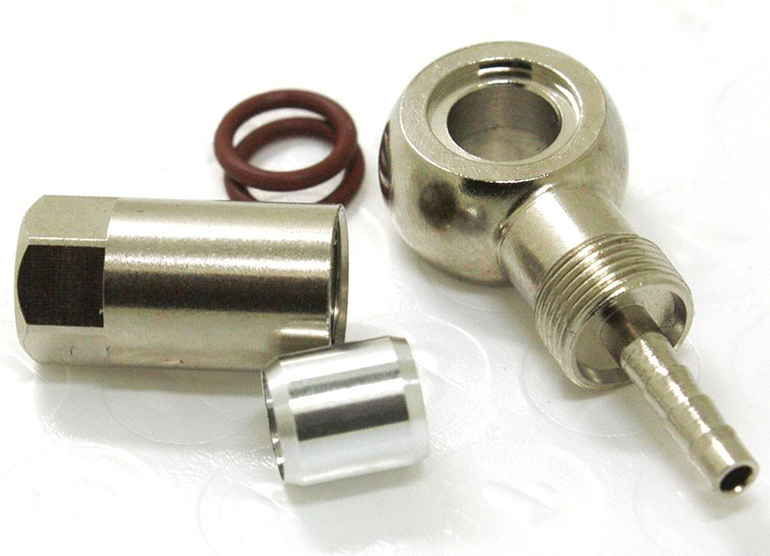By Josh Cosford, Contributing Editor
There isn’t much in the fluid power world taking a unique spin on a familiar concept. Pumps, valves and actuators operate and look much the same as decades ago, especially if you ignore electronic advancements. Hydraulic components like the internal gear pump and electrohydraulic actuator are certainly worth your time to learn, but sometimes it’s the everyday applications that surprise you the most.
 Banjo fittings bring the “why didn’t I think of that?” mind frame to hydraulic hose technology. The bolt, fitting and two washers combine to offer a hydraulic hose end with a 360° range of motion and high-pressure operation. In addition, the cross-drill in the bolt combined with the internal groove in the fittings provides a two-way flow path sealed by the washers regardless of installation direction.
Banjo fittings bring the “why didn’t I think of that?” mind frame to hydraulic hose technology. The bolt, fitting and two washers combine to offer a hydraulic hose end with a 360° range of motion and high-pressure operation. In addition, the cross-drill in the bolt combined with the internal groove in the fittings provides a two-way flow path sealed by the washers regardless of installation direction.
Other hose connections and adaptors may offer permanent or live connections that allow full rotation, but the low-profile advantage of the banjo fitting is hard to beat. In addition, a 90° JIC female hose end allows the technician to connect the hose at any angle or even loosen the fitting to pivot the hose at any time afterward.
One example of minimum installed height compares ½ in. ORB banjo hose end to ½ in. JIC hose end. The banjo assembly comes in at 37.5 mm (about 1.5 in.), while the JIC low profile comes in at over 50 mm (about 2 in.) when you include the hose height.
It should be said that banjo fittings and hose ends find themselves primarily on European and Asian applications, so BSPP and metric are more common thread types. If you’ve done the brakes on your own car, and especially if you’ve had to remove the calipers, you may have found banjo bolts as the fitting of choice for your brake lines.
Like ORB, JIC or NPT, hose end sizes may differ from the fitting size. For example, you may find ¼ in. NPT male on the end of a ½ in. hydraulic hose. However, that combination makes for a less common hose end. Fluid power distributors and hose shops often stock separate ferrules and stems to combine as needed to match the hose size with the fitting size. Stocking one ferrule SKU for each hose ID allows the technician to simply choose the stem with the fitting for their application. Those stems are less expensive than their one-piece counterparts.
Banjo bolts and hose ends seal at the base and the top using crush washers, usually made from copper or bonded seals as the bolt is torqued into the port, which seals each end while locking the fitting in place. However, copper crush washers flatten over time, so some technicians prefer bonded seals using a metal backing with synthetic rubber soft seal in the ID.
The banjo fitting is a rare animal, especially here in North America. However, banjo fittings are functional and versatile, so they deserve more attention from technicians and designers. I see them especially useful as workports in cylinders and motors, where their slim profile offers up a clean installation.
Filed Under: Couplings & Fittings, Engineering Basics, Fittings, Couplings & Adapters, Hose & Tubing, Hose Assembly Tips